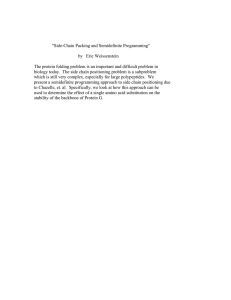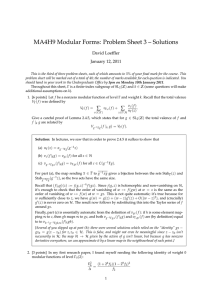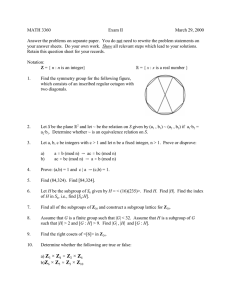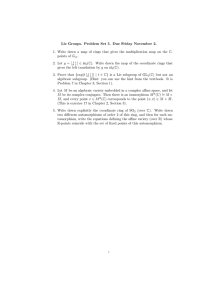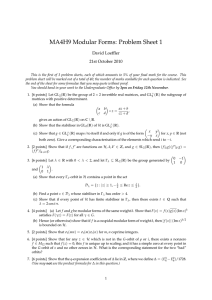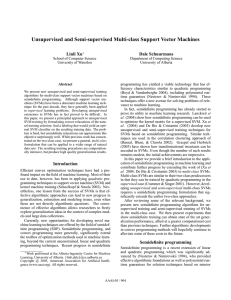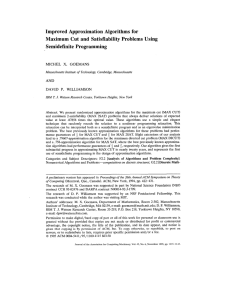MA4H9 Modular Forms: Problem Sheet 3 David Loeffler December 3, 2010
advertisement
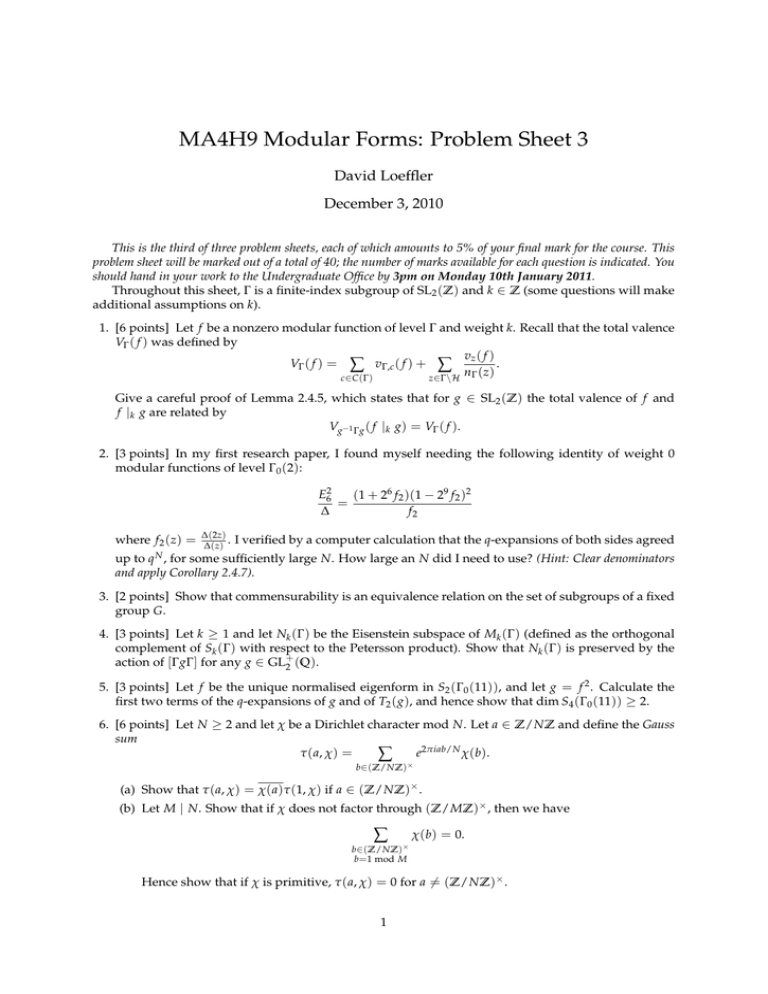
MA4H9 Modular Forms: Problem Sheet 3 David Loeffler December 3, 2010 This is the third of three problem sheets, each of which amounts to 5% of your final mark for the course. This problem sheet will be marked out of a total of 40; the number of marks available for each question is indicated. You should hand in your work to the Undergraduate Office by 3pm on Monday 10th January 2011. Throughout this sheet, Γ is a finite-index subgroup of SL2 (Z) and k ∈ Z (some questions will make additional assumptions on k). 1. [6 points] Let f be a nonzero modular function of level Γ and weight k. Recall that the total valence VΓ ( f ) was defined by vz ( f ) . VΓ ( f ) = ∑ vΓ,c ( f ) + ∑ n (z) c∈C (Γ) z∈Γ\H Γ Give a careful proof of Lemma 2.4.5, which states that for g ∈ SL2 (Z) the total valence of f and f |k g are related by Vg−1 Γg ( f |k g) = VΓ ( f ). 2. [3 points] In my first research paper, I found myself needing the following identity of weight 0 modular functions of level Γ0 (2): E62 (1 + 26 f 2 )(1 − 29 f 2 )2 = ∆ f2 where f 2 (z) = ∆(2z) . ∆(z) I verified by a computer calculation that the q-expansions of both sides agreed qN , up to for some sufficiently large N. How large an N did I need to use? (Hint: Clear denominators and apply Corollary 2.4.7). 3. [2 points] Show that commensurability is an equivalence relation on the set of subgroups of a fixed group G. 4. [3 points] Let k ≥ 1 and let Nk (Γ) be the Eisenstein subspace of Mk (Γ) (defined as the orthogonal complement of Sk (Γ) with respect to the Petersson product). Show that Nk (Γ) is preserved by the action of [ΓgΓ] for any g ∈ GL2+ (Q). 5. [3 points] Let f be the unique normalised eigenform in S2 (Γ0 (11)), and let g = f 2 . Calculate the first two terms of the q-expansions of g and of T2 ( g), and hence show that dim S4 (Γ0 (11)) ≥ 2. 6. [6 points] Let N ≥ 2 and let χ be a Dirichlet character mod N. Let a ∈ Z/NZ and define the Gauss sum τ ( a, χ) = ∑ e2πiab/N χ(b). b∈(Z/NZ)× (a) Show that τ ( a, χ) = χ( a)τ (1, χ) if a ∈ (Z/NZ)× . (b) Let M | N. Show that if χ does not factor through (Z/MZ)× , then we have ∑ χ(b) = 0. b∈(Z/NZ)× b=1 mod M Hence show that if χ is primitive, τ ( a, χ) = 0 for a 6= (Z/NZ)× . 1 (c) Calculate τ (1, χ) when N = p j (p prime, j ≥ 1) and χ is the trivial character mod p j . b to be the subgroup of 7. [4 points] Let N ≥ 2 and let H be a subgroup of (Z/NZ)× . Define H Dirichlet characters χ mod N such that χ(d) = 1 for all d ∈ H. a b (a) Show that Γ H ( N ) = ∈ Γ0 ( N ) : a, d ∈ H is a finite-index subgroup of SL2 (Z). cN d (b) Show that for any k ≥ 1 we have Sk (Γ H ( N )) = M Sk ( Γ1 ( N ), χ ). b χ∈ H 8. [4 points] Suppose p is a prime, Γ = Γ1 ( p) and g = GL2+ (Q) such that ΓgΓ = G Γg j = 0≤ j < p 0 . Find p matrices ( g j ) j=0,...,p−1 in p 1 0 G g j Γ. 0≤ j < p 9. [5 points] Let V be a finite-dimensional complex vector space endowed with a positive definite inner product (a finite-dimensional Hilbert space). Let A : V → V be a linear operator. (a) Show that if A is selfadjoint, h Ax, x i is real for all x ∈ V. (b) We say A is positive semidefinite if it is selfadjoint and h Ax, x i ≥ 0 for all x ∈ V. Show that if A is positive semidefinite, there is a unique positive semidefinite B such that B2 = A. (We write √ B = A.) (c) Show that for any linear operator A, the operator A∗ A is positive semidefinite, and if P = √ ∗ A A, then we may write A = UP with U unitary. Show √ conversely that if A = UP with U unitary and P positive semidefinite, we must have P = A∗ A. Is U uniquely determined? (d) Show that A is normal if and only if we can find a unitary U and positive semidefinite P such that A = UP and U and P commute. (e) Find an example of a nondegenerate (but not positive definite!) inner product space V and a linear operator A : V → V which is normal but not diagonalisable. 10. [4 points] Let f be weakly modular of level Γ and weight k. Let f ∗ : H → C be the function defined ∗ ( z ) = f (− z ). Show that f ∗ is weakly modular of weight k and level Γ∗ = σ −1 Γσ, where by f −1 0 σ= . 0 1 Show that f ∗ is a modular function, modular form, or cusp form if and only if f is, and that the q-expansions of f ∗ and f at ∞ are related by an ( f ∗ ) = an ( f ). 11. [Non-assessed and for amusement only] Let M(Γ) = k≥0 Mk (Γ), which is clearly a ring. Show that for any Γ, M (Γ) is finitely generated as an algebra over C, and we may take the generators to have weight at most 12. L Page 2
